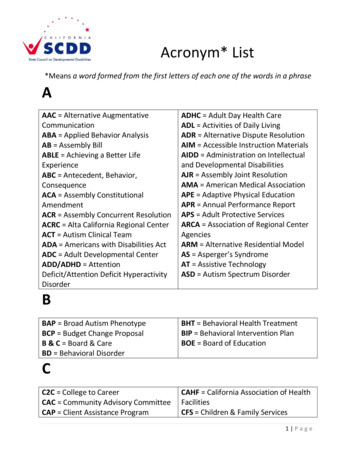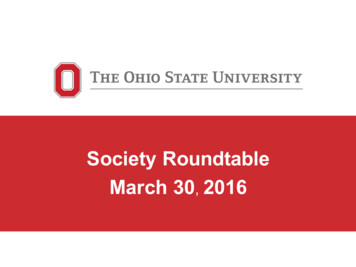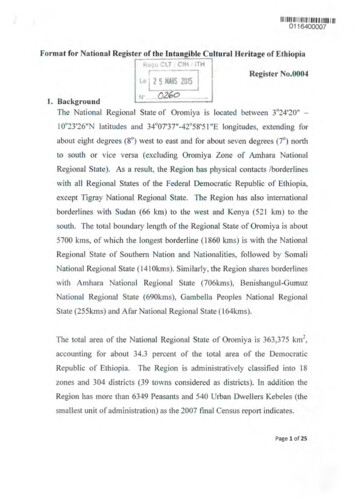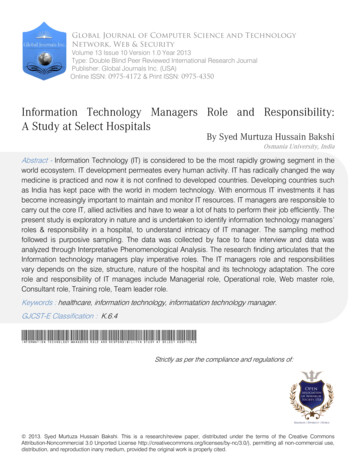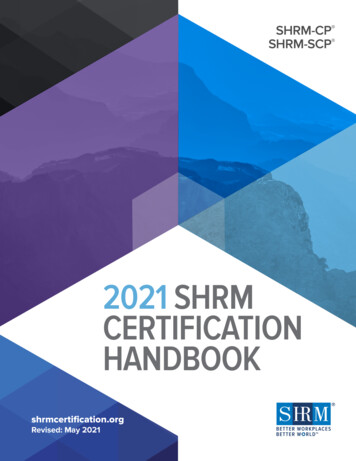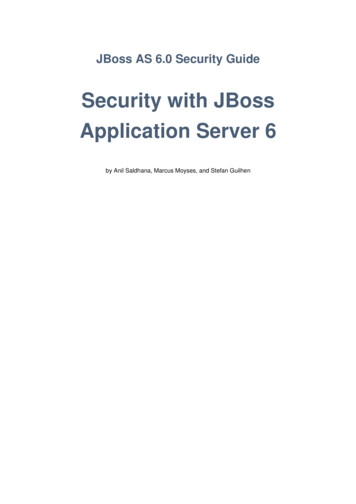
Transcription
By Kidist MulugetaThe Role of Regional andInternational Organizationsin Resolving the SomaliConflict: The Case of IGADSubmitted to Friedrich Ebert-Stiftung, Addis AbabaDecember, 2009
KIDIST MULUGETA THE CASE OF IGADTable of ContentList of Abbreviations .5List of Tables .6List of Figures .6List of Appendices.6Executive Summary .7Introduction .8CHAPTER ONE: THE SOMALI CONFLICT .91.1 The Causes of the Somali Conflict . .91.1.1. Root Causes .91.1.2. Aggravating Factors .101.2. The Implications of the Somali Conflict . 111.2.1. Local Implications . 111.2.2. Implications for the Regional States and the International Community . .151.3. Attempted Conflict Resolution Efforts .161.3.1. International Intervention .161.3.2. Peace Talks . 171.4. Current Development . 171.4.1. Political Development in Somalia . .181.4.2. The Issue of Security .191.4.3. The Government Institutions .20CHAPTER TWO: IGAD’S ROLE IN SOMALIA .222.1. Background to IGAD . .222.1.1. The Origin of IGAD . .222.1.2. Vision, Mission, Principles, and Major Activities of IGAD.232.1.3. Organs of IGAD . .232.1.4. Draft Peace and Security Strategy of IGAD .242.1.5. Ongoing Revitalization . .252.2. IGAD’s Role in Somalia .252.2.1. IGAD Member States and the Somali Conflict .262.2.2. IGAD’s Involvement from 1991 to 2002 .262.2.3. The Role of IGAD in the Establishment of the TFG of Somalia: The Eldoret Peace Process .282.2.4. The Establishment of the TFG II and IGAD .342.3. IGAD’s Achievements in its Effort to Resolve the Somali Conflict .352.3.1. The Continuous Engagement of IGAD .352.3.2. The Commitment of the Member States of IGAD . .352.3.3. The Efforts of the IGAD Secretariat .362.3.4. IGAD as a Forum for Member States . .372.4. The Challenges of IGAD in Somali Peace Making and Lessons to be Learned . .372.4.1. The Complexity of the Somali Conflict .372.4.2. Regional Factors .383
KIDIST MULUGETA THE CASE OF IGAD2.4.3. Different Approaches in Addressing the Somali Conflict . .402.4.4. The Limited Capacity of the Secretariat of IGAD .412.4.5. The Neutrality and Enforcement Capacity of IGAD.432.4.6. Lack of Regional Policy on Peace and Security.442.4.7. Lack of Sufficient and Appropriate International Commitment.442.5. IGAD, the AU and the UN .45CHAPTER THREE: The Role of the African Union and the United Nations .463.1. The Role of the AU .463.1.1. Background to AMISO .463.1.2. AMISOM in Somalia .463.2. The Role of the UN in Somalia .473.2.1. The United Nations Political Office for Somalia (UNPOS) . .483.2.2. The UN Support to the TFG II .483.2.3. The UN Support to AMISOM .49Conclusion . .50Recommendations . 51Bibliography . .54Appendix . .604
KIDIST MULUGETA THE CASE OF IGADList of AbbreviationsAAUAddis Ababa UniversitySCICSupreme Council of Islamic Courts of SomaliaAUAfrican UnionSCSCSupreme Council of Sharia CourtsAFPAgence France-PresseSDMSomali Democratic MovementAMISOM African Union Peacekeeping Mission inSomaliaSNMSomali National MovementSPMSomali Patriotic MovementARSAlliance for the Re-liberation for SomaliaSNRPSomali National Reconciliation ProcessARS-AAlliance for the Re-liberation forSomalia-AsmaraSRRCSomali Restoration and Reconciliation CouncilARS-DAlliance for the Re-liberation forSomalia-DjiboutiSRSGSpecial Representative of the Secretary-GeneralSSDFSomali Salvation Democratic FrontCEN-SAD Community of Sahelo-Saharian StatesTFGTransitional Federal GovernmentCEWARN Conflict Early Warning NetworkTFG IITransitional Federal Government IICSOsCivil Society OrganizationsTNGTransitional National GovernmentDDRDemobilization, Disarmament andReintegrationUICUnion of Islamic CourtsUNUnited NationsDPADepartment of Political AffairsUNDPUnited Nations Development ProgrammeEACEast African CommunityUNHCRUnited Nations High Commission forRefugeesUnited Nations Children’s FundECOWAS Economic Community of West African StatesEUEuropean UnionUNICEFHLCHigh Level CommitteeUNISOM United Nations Mission in SomaliaICCJInternational Criminal Court of JusticeUNSOAUN Support Office for AMISOMICGInternational Crisis GroupUNITAFUnified Task ForceICJInternational Court of JusticeUNOSOM United Nations Operation in SomaliaICPATIGAD Capacity Building Programmeagainst TerrorismUNPOSUnited Nations Political Office for SomaliaUNSCUnited Nations Security CouncilIDPsInternally Displaced PeoplesUSUnited StatesIGADInter-Governmental Authority for DevelopmentUSCUnited Somali CongressIGADDInter-Governmental Authority on Droughtand DesertificationIGASOM IGAD Peace Keeping Mission to SomaliaIPFIGAD Partners ForumJSCJoint Security CommitteeMOFAMinistry of Foreign AffairsOAUOrganization of African UnionPSCPeace and Security CouncilREC’sRegional Economic CommunitiesSADCSouthern Africa Development CommunitySALWSmall Arms and Light Weapons5
KIDIST MULUGETA THE CASE OF IGADListsList of TablesTable 1: Area, Population, Religious Composition, MilitaryBudget and Personnel Strength of IGAD Member StatesTable 2: Selected Inter-State Conflicts among IGADMember statesTable 3: Selected Intra-State Conflicts in the IGAD Member StatesTable 4: Total Accumulated Unpaid Contributions of theIGAD member states from 2000-2006List of FiguresFigure 1: IGAD Organizational StructureFigure 2: IGAD Office for SomaliaList of AppendicesAppendix 1: List of Interviewed PersonalitiesAppendix 2: Clan Groups in SomaliaAppendix 3: Political Map of SomaliaAppendix 4: Interview Questions6
KIDIST MULUGETA THE CASE OF IGADExecutive SummaryAs a regional organisation, the role of the African Union (AU) in Somalia has been marginal. The AU has deployed peacekeeping troops, though they are struggling tostrengthen their presence in Somalia. The Mission hasitself become embroiled in the conflict between the government troops and insurgent groups. Its presence inSomalia, however, has effectively ensured the continuityof the weak Transitional Federal Government.In general, regional and international organizationshave provided a vital forum for various actors to addressthe conflict in Somalia. Mobilisation of funds and support for various initiatives in Somalia has so far beenshouldered by these organizations. It has to be notedthat IGAD in particular has made a significant contribution in terms of trying to resolve the Somali conflict. Ifthese organisations effectively coordinate their actionsand that of their member states, a stable Somalia whichis not a safe haven for terrorists and pirates as well as asource of refugees, internally displaced persons and lightweapons may be possibly restored.Somalia is the only country in the world without a functioning government controlling the entirety of its territory for nearly two decades. Since 1991, while Somalilandand Puntland have enjoyed relative stability, the southernpart has been raked by violence as various clans, warlords and Islamist groups have repeatedly competed forpower and resources. Somalia’s ongoing conflict in oneof the most unstable regions of Africa has been a sourceof concern for regional States as well as regional and international Organisations.Intergovernmental Authority on Development(IGAD),as a regional organization, has been consistently engaged in trying to resolve the prolonged conflict of Somalia. IGAD member states have committed their resources,time and energy in dealing with this conflict, essentiallyneglected by the international community. The majorobstacles to various peace initiatives, however, are withinSomalia. The conflict has complicated the issue of powersharing, resource allocation, land and properties. It hasalso deepened the existing clan division which was always manipulated by political elites in order to achievetheir narrow interests at the expense of the nationalagenda. The mushrooming of political elites or/and otherstakeholders benefiting from the ongoing chaos hasfurther contributed to the failure of various initiatives.The role of external actors is either negligible or is fueling the conflict in Somalia. Both state and non-state actors have been providing at different times weapons andfinance to different warring groups. Neighboring states,Arab states and Western states have been drawn intoSomalia’s conflict for various reasons including terroristand security concerns. At the regional level, the conflicting interests of IGAD member states in Somalia made itvery difficult for the adoption of a common position.IGAD member states are weakened by inter-state andintra-state conflicts, poverty and humanitarian criseswhich is draining the capacity and focus of IGAD itself.Indeed, IGAD as an institution faces many challenges.The organisation lacks autonomy and capacity to successfully handle a very complex conflict like Somalia. Italso lacks the financial capacity to push successfully andforcefully its peace initiatives forward. Yet, despite thesechallenges, IGAD has been instrumental in bringing theSomali crisis to the attention of the international community.7
KIDIST MULUGETA THE CASE OF IGADIntroductionthe African Union (AU), particularly African Union Mission in Somalia (AMISOM), and the United Nations (UN)are also briefly analyzed. This study contributes to theongoing discussion on conflict and conflict resolution inthe Horn of Africa by analyzing the peace initiatives taken by IGAD in the past two decades. It will also serve asa source of information and catalyst for further studies.The major issue that the study examines is the role ofIGAD in resolving the Somali conflict. It also examinesthe conflict resolution mechanisms of IGAD as a regionalorganization. In doing so, the study focuses on the following research questions. What are the factors that led toIGAD’s engagement with the Somali conflict? Who arethe main actors behind IGAD’s involvement? What arethe interests of member states? Does IGAD have the institutional capacity and the political will to deal with thecomplex and prolonged conflict in Somalia?Somalia is engulfed in a Hobbesian world, virtually “awar of all against all.” A confluence of factors includingcolonial legacy, external intervention, clannism, SiadBarre’s dictatorship, and the intensification of armed opposition contributed to the disintegration of Somalia in1991. Somalia has been struggling, since then, with thecomplete absence of a functioning central governmentand consequently of law and order.The Somali people have gone through all kinds of miseryin the past two decades. The anarchy, violence, andpoverty forced many Somalis to be displaced, becomerefugees, and thousands lost their lives. The effects ofthe general anarchy in Somalia have not only affectedthe population of Somalia, they have also had a spillovereffect to the Horn of Africa region and the internationalcommunity. The problem of refugees, the smuggling ofsmall arms and light weapons, the spreading of terrorism, and radicalization are all threats emerging fromSomalia, mainly affecting the Intergovernmental Authority on Development (IGAD) member states. IGAD has,therefore, been engaged with the Somali conflict foralmost two decades.Established in 1986 with the objective of addressingthe environmental degradation of the Horn of Africa,IGAD was revitalized in 1996 with a broader mandate ofresolving the conflicts in the region, including the Somaliconflict. IGAD has been active on the issue of Somaliasince 1991. A series of peace initiatives were organizedby IGAD member states under the mandate of IGAD.Though weak, the Transitional Federal Government(TFG), which was created by the peace process organizedunder the auspicious of IGAD in 2004, has internationalbacking and is still serving as a stepping stone for furtherreconciliation. IGAD’s conflict resolution effort in Somalia has been, however, challenged by a number of internal and external factors. IGAD has been principally characterized by a lack of political will and grave constraintsof resources—human, financial, and logistic—whichhave impeded it from living up to its expectations. IGADis also weak due to the widespread inter- and intrastateconflicts and poverty that make the region extremely volatile. Neither is the role of external actors in undermining IGAD’s peace initiatives in Somalia negligible.In broader terms, this study is designed to examineIGAD’s institutional, political, and financial capacity fordealing with the prolonged Somali conflict. Efforts byMethodologyApproachThe fact that the study seeks to explain the complexcauses of the Somali conflict and how it affected the regional and international security means that the approach has to be analytical. On the other hand, there hasbeen a necessity to consider the numerous peace effortsmade by IGAD, the AU, and the UN to resolve the conflict. In this case, negotiations, conferences, and actionsof IGAD, the AU, and the UN are briefly studied. Such anapproach is basically descriptive. The study thereforeuses both analytical and descriptive approaches.Data collectionThe principal sources of data are documents and academic literature. These include books, articles, media publications, and different reports. In order to strengthen aspects of the data provided by these writings, the researcherinterviewed thirty-five individuals including: experts on Somalia, academicians from research centers and universities,and middle-level officials from international and regionalorganizations. The researcher actually conducted two fieldtrips to Kenya and Djibouti for these interviews.8
KIDIST MULUGETA THE CASE OF IGADChapter One:The Somali ConflictOrganization of the StudyThe research is organized as follows. The first chapterintroduces the causes and implications of the Somaliconflict. The second chapter assesses the peace processes led by IGAD and the successes and challenges ofIGAD in dealing with Somalia. The third and final chapterbriefly examines the role of the AU and the UN in dealingwith the Somali conflict.1.1. The Causes of the SomaliConflictThree basic reasons are mentioned by most scholars asthe root causes for the Somali conflict and the subsequent disintegration of the state. These are colonial legacy, clan system, and economic factors.1.1.1. Root CausesColonial LegacyMost conflicts in Africa could be traced back to Europeancolonialism. In this regard, Somalia, as one of the colonies of the European states, is not an exception. The colonial powers (Britain, Italy, and France) partitioned Somalia into five parts. Britain took two parts (BritishSomaliland and the northern territory of Kenya), Italy onepart known as Italian Somaliland, France the northerncoast, and the rest was occupied by Ethiopia (the Ogaden). The subsequent attempt to reintegrate these different Somali-inhabited parts led the state, which emergedin 1960, to enter into conflicts with neighboring statesand eventually to disintegration. Colonialism also poseda serious challenge to national integration in the postindependence period because of the distinct colonial experiences of the British Somaliland and Italian Somalilandwhich formed the independent Republic of Somalia (Petrides 1980; Mesfin 1964).Clan SystemColonialism being the external factor in the Somali crisis,there is a more important and fundamental factor in theSomali life clan system. Somalis speak the same language, adhere to the same religion, and are from the sameethnic group, which is rare in the case of Africa. Althoughsuch homogeneity should have been an asset to build anation state, clannism has long hindered internal cohesion in Somalia. There are five major clans in Somalia: Darood, Hawiye, Rahanwyeen, Isaaq, and Dir, and eachclan has its sub-clans. Clans and sub-clans play a very9
KIDIST MULUGETA THE CASE OF IGADthe worst human rights record and his administrationwas also known for corruption, political patronage, personalized leadership, and absence of any room for accommodation. African Watch estimated that during his timein power, Barre killed up to 60,000 civilians (Africa WatchReport 1990, 28; also see Adam 1995, and Woodward1995).important role in defining the political, economic and social landscape of Somalia.Clannism is partly related to the Somali pastoralist culture. Over 80 percent of the Somali people are pastoralists, lacking the culture of a centralized administrativesystem and promoting loyalty to their kin and clans. Thedivision between clans has also widened over the yearsdue to competition over resources, elite manipulation,and political patronage. For instance, during twenty years in power (1969–1991), Siad Barre introduced a clanbased divide and rule policy. Barre developed his ownmechanism of appointing loyal political agents from hisown clan to guide and control civil and military institutions. Besides the political favoritism, his clansmen—theMarehan clan of Darod—also benefited from the economic system. Barre’s policy instigated suspicion and hatred among the clans and finally led the country into deepstatelessness. Moreover, the struggle for scarce resources between different clans and sub-clans left Somaliadivided (Latin and Samatar 1987, 29; Zartman 1995, 4;Prunier 1988, 24).Ogaden WarThe 1977–1978 Ogaden war was initiated by Somalia tofulfill its long-awaited dream of creating a Greater Somalia by reintegrating the Ogaden into the Somali republic.The integration of the Ogaden into the larger SomaliRepublic was meant to boost Somali nationalism andthereby unite the country into one nation-state. Nonetheless, the war turned unpleasant for Somalia in early 1978,when it was defeated by Ethiopia, with the support ofthe Soviet Union and Cuba. Somalia’s defeat weakenedBarre politically and intensified internal opposition (Mulugeta 2008). After the defeat, a group of disgruntledarmy officers attempted a coup d’état in 1978 and rebelmovements were established and launched attacksagainst Barre with the support of Ethiopia, which furtherexacerbated the conflict (Brons 2001, 184; see also Ayoob1980, 147–148 and Negussay 1984, 54).Economic FactorsCompetition for economic resources is also a major causefor the Somali conflict. Clashes over resources such aswater, livestock, and grazing have always been a sourceof contention in Somalia, both before and after independence. In the post-independence period, competitionover state power involved securing the major economicresources. This coupled with economic mismanagement,corruption, and failure to meet the people’s expectationsand provide them basic services by successive regimesled to increasing poverty and further discontent.Cold War LegacySomalia’s strategic position on the Red Sea and IndianOcean had attracted the attention of both superpowers,the US and USSR, especially during the Cold War to gainand maintain access to Middle Eastern oil. In the 1960sand early 1970s, Somalia was strongly supported by theSoviet Union in terms of military and financial aid. Whenthe Soviet Union shifted its support to Ethiopia in 1977,Barre, in turn, sought the support of the West—particularly the US. The successive support from the two superpowers sustained Barre’s dictatorship, which led togrowing internal opposition and the subsequent disintegration of the state (Zartman 1995, 28; Kinfe 2002, 28).1.1.2. Aggravating FactorsBarre’s DictatorshipGeneral Siad Barre came to power through a bloodlessmilitary coup, overthrowing the civilian government in1969. He initially gained the support of the people byestablishing self-help community projects and buildinghealth and education services. Nonetheless, he eventually became a tyrant, unmindful of the human cost inprolonging his grip on power. Under Barre, Somalia had10
KIDIST MULUGETA THE CASE OF IGADIntensification of the Armed Struggleagainst Barre’s RuleBrons 2001). The health services and school enrollment isalso the lowest in the world.A number of clan-based rebel movements emerged inSomalia during the late 1970s and the 1980s, largely inresponse to Barre’s brutality and his divide and rule policy. The Darood-dominated Somali Salvation DemocraticFront (SSDF), the Isaaq-dominated Somali NationalMovement (SNM), and the Hawiye-dominated UnitedSomali Congress (USC) were the major rebel movementsthat launched military attacks and toppled Barre out ofpower. The subsequent failure of the various rebel movements to agree on terms for the establishment of a viablepost-Barre government led to the total breakdown oflaw and order (Sorenson 1995, 28; Zartman 1995, 75).Humanitarian ImplicationsSomalia has seen the world’s most dreadful humanitariancrisis since the state collapsed in 1991. Recently, out ofthe total estimated nine million people: over 3.2 million are in dire need of humanitarian assistance; over 1.2 million have been displaced; hundreds of thousands have lost their lives as a resultof the civil war; up to 300,000 children are acutely malnourishedannually, which is the highest in the world (UNHCR2008; also see Keck 2009).The humanitarian situation is aggravated by a confluenceof factors including violence, drought, increasing foodprices, piracy, increasing inflation rate, and targeted killings of humanitarian workers.The delivery of aid has shown a substantial reductionsince Al-Shabaab controlled larger territories in the southand central parts of Somalia. This is mainly due to thethreat from some of the Al-Shabaab units, like the casein Bidoa and Jowhar. According to the UNICEF informant,forty-two aid workers have been killed and abductedsince January 2008. Some of UNICEF’s humanitariansupplies—amounting up to US 3 million—were also looted and destroyed by the Al-Shabaab in Jowhar on May17, 2009 (Interview with UNICEF official).To make matters worse, the UN and the US suspendedaid shipment to southern Somalia. The former in fear ofthreats from the Al-Shabaab, while the latter claimedthat aid could feed the war and might end up in thehands of terrorists (ICG 2008; and see IRIN 2009). According to WFP, the Al-Shabaab also issued unacceptabledemands including “the removal of women from all jobsand the payment of US 20,000 for protection every sixmonths from each of the regional offices” (Daniel 2010);it was ordered to leave when it refused to accept thedemands (Daniel). Some argue that donors have genuinecause, while others suspect that they are using aid as aweapon to make people fight the Al-Shabaab, which isblamed for the substantial reduction (Interview withOxfam informant).Some observers argue that Somalia does not need aidat all, claiming that people are not starved in Somalia.1.2. The Implications of the SomaliConflict1.2.1. Local ImplicationsFor the last two decades, Somalia has been sufferingfrom lawlessness due to non-existent state institutions,highly factionalized political groups, and repeated external intervention. The protracted conflict in Somalia hashad an overall impact that is manifested in the economic,social, and political arena.Economic and Social ImplicationsThe conflict in Somalia affected its formal economic system. The flourishing of the black economy (unregulatedmarket including chat, banana, charcoal) after 1991 onlymade a few groups or individuals inside and outsideSomalia beneficiaries. These, in turn, became backers ofthe numerous rebel movements and warlords. Moreover,in the absence of a central government the rate of unemployed increased at an alarming rate over the years, “47percent of economically active population is unemployedin Somalia” (Maimbo 2006; Interview with SomaliAnalyst One). A large majority of the people, up to 40percent of the urban households are dependent on remittances. Some argue that even the remittances haveshown substantial reduction due the current financialand economic crisis (Interview with Somali Analyst One;11
KIDIST MULUGETA THE CASE OF IGADAl-ItihadAccording to Ali Wahad Abdullahi, a Mogadishu resident, there is enough food in Somalia and people livethrough remittance and support each other. He addedthat aid agencies exaggerate humanitarian conditions inSomalia to serve their interest. Some argue that theagencies themselves have become warlords, who wantto see the perpetuation of the conflict as their carriersare dependent on it. Moreover, a huge amount of moneyis said to be spent on covering the operational costs ofthe agencies. And, since most aid agencies are based inNairobi, they have a very weak monitoring mechanism.As a result, the local partners are said to be enrichingthemselves (Interview with Ali Wahad Abdullahi).It is true that the agencies spend money to cover highoperational costs like renting chartered airplanes andships to deliver aid. This should not, however, lead to theconclusion that aid should be stopped. People are suffering from the ongoing conflict. The Dadaab camp in Ken
also lacks the financial capacity to push successfully and forcefully its peace initiatives forward. Yet, despite these challenges, IGAD has been instrumental in bringing the Somali crisis to the attention of the international commu-nity. As a regional organisation, the role of the African Uni-on (AU) in Somalia has been marginal. The AU has deplo-



